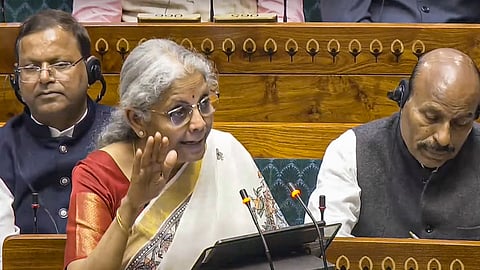Manmohan Singh would have readily agreed that his 1991 economic doctrine has run its course. But this budget fails to present a new paradigm. Rather than getting out of the way of entrepreneurs, as the Economic Survey recommended, it meddles more in some areas
Praveen Chakravarty
February 02, 2025

Union Finance Minister Nirmala Sitharaman presents the Union Budget 2025-26 in the Lok Sabha, in New Delhi, Saturday.Photo | PTI
In his parliament speech on Budget 2024, Leader of the Opposition Rahul Gandhi had taunted the government by showing a picture of the finance minister and her mostly upper-caste officers participating in the ritualistic ‘budget halwa ceremony’ and asked metaphorically why India’s budget halwa was not being shared proportionately with the oppressed sections. What was the FM’s response? She banned pictures of this year’s halwa ceremony. Rather than taking away the larger message of a need for equity in the budget, the FM resorted to doing away with the headlines on the halwa ceremony. This sums up Budget 2025—knee-jerk, shallow and missing the forest for the trees.
Right or wrong, there were tremendous expectations of an overhaul in India’s economic thought and framework. If not an equitable halwa, there was an expectation of a nice, spicy biryani. But what we got instead was a banal mix of Bihar campaign rhetoric in the disguise of a budget, a bone for the few million barking salaried taxpayers and tinkering of the exports boat that was at the risk of sinking.
While the increase in income tax exemption threshold to Rs 12 lakh is welcome and has garnered the maximum attention, it was merely a reaction to the years-long clamour of the salaried class. If the larger intent was to boost consumption, then, along with the tax relief, the FM should have signalled a firm commitment to reduce GST rates, which would have provided a more immediate and greater fillip.
Strangely, the budget was in dissonance with the Economic Survey despite both emanating from a few metres of each other in North Block. The survey called for the government to ‘get out of the way’ and build trust in people to foster growth. The budget seeks to ‘get more in the way’ through a series of measures on import duties, setting up of new boards, councils and committees and shifting definitions of what constitute small and micro businesses.
During the late 1990s and early 2000s, when India was getting global acclaim for its information technology industry and winners of global beauty pageants, it was famously said that the nation did well in ‘IT and beauty’ because the government understood neither, and hence didn’t get in the way. This budget reversed it through a needless splurge of taxpayer funds on start-ups, where the private sector has already demonstrated its capacity to fund.
When there is palpable nervousness about Donald Trump’s promise to upend the global economic order, the budget does very little to soothe nerves and outline a cohesive vision for India’s role in the new order. While protectionism and economic nationalism may be in other nations’ interest, history has shown exporting is the path to prosperity for developing nations like India. It’s laudable that the FM recognised this and, for the first time, highlighted exports as a pillar of growth, but the budget did very little to articulate a comprehensive export strategy. Exports need a combination of market access, flexible currency, low import duties and business incentives. Instead, what we got was a spattering of customs duty cuts on some items.
Former prime minister and the father of the 1991 economic reforms Manmohan Singh would have readily acknowledged that the 1991 economic doctrine has run its course and the country needs a new paradigm. This was also the expectation of most economists and experts across the ideological spectrum. Alas, Budget 2025 has disappointed on this front and turned out to be a mundane affair. The chief economic advisor’s advice to ‘get out of the way’ was sound and built up hopes.
The best indictment came not from the opposition, but from the treasury benches. Count the number of times tables were thumped during each budget speech from 2014 to 2025, and you will understand how 2025 drew the most lacklustre response.
Praveen Chakravarty
Chairman, All India Professionals’ Congress, and a political economist
https://www.newindianexpress.com/opinions/2025/Feb/01/budget-2025-neither-a-halwa-nor-a-biryani

